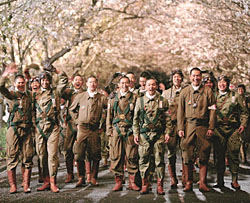Kim Do-hyeong
Here in Tokyo, I saw two movies last week. One was a feature, and the other was a documentary. Both were about Japan’s Kamikaze pilots in World War II.
“I wanted to convey the corps’ beauty to young people today.” So writes Tokyo mayor Ishihara Shintaro at the start of “For Those We Love,” (Ore wa kimi no tame ni koso shini ni iku the feature film. Ishihara is the film’s executive producer and scriptwriter.
Ishihara’s ability to move audiences by having them discover the “beauty” of the Kamikaze pilots instead of any “madness” on their part, the beauty of their glorious self-sacrifice, was far more skilled and clever than I thought it could be.

The kamikaze in the Ishihara film
The story unfolds from the perspective of Torihama Tome, who operated a restaurant frequented by the pilots before their sorties and who was a second mother to many of them. While watching, I heard others in the audience crying at the many images of men in their late teens and early twenties who fell in the name of patriotism under the orders of the state.

Seeing off the kamikaze, 1945
Looking at the audience reviews at Yahoo! Japan, it seems that Ishihara’s film has had much of the desired effect.
“They possessed values more important than life, perhaps something that we who live today no longer have,” wrote one moviegoer.
“Might not the peace we have today come from their sacrifices?” asks another.
Torihama is played by the famous 75 year-old actress Kishi Keiko. The film’s success might be because she rejected Ishihara’s first script, several times, saying it “glorifies war too much,” leading to the film’s content being softened somewhat.

Torihama and pilots in a 1945 photo
Still, the film’s political message is simultaneously suggestive and clear, with lines like “We shall meet in death at Yasukuni Shrine,” or “We were right to start a war to liberate Asia from the whites.”
The climax comes when admiral Onishi Takijiro, “Father of the Kamikaze,” commits ritual suicide to take responsibility for the war. In the film, his final words are that he will die a painful death to atone for the spirits of the deceased pilots, and does not want anyone to act as a “second” in his act of seppuku – cutting his belly open with a knife – by beheading him to make his death more comfortable. That is how Ishihara frames responsibility for the kamikaze. What he does not show is that only two or three Japanese brass gave up their lives to bear responsibility like Onishi for the more than 4,000 young men who died in the air attacks.
Former Japanese prime minister Koizumi Junichiro’s yearly visits to worship at Yasukuni Shrine during his five years in office were not unrelated to his feelings for the Kamikaze.
In February 2001, two months before the election in which he ran for chairman of the ruling Liberal Democratic Party, Koizumi visited the Chiran Peace Museum for Kamikaze Pilots in Chiran, Kagoshima Prefecture, where Torihama’s restaurant was and where the film takes place. He cried at great length in front of a display of pilots’ last wills and testaments and other personal effects. Kato Koichi, a former Chief Cabinet Secretary, writes in The Real Criminal Behind the Terror that it was probably when Koizumi returned from shedding tears at Chiran that he decided he would go to Yasukuni shrine to worship.
On May 15, I went to a preview showing of a documentary, Tokko (Special Attack Force), by director Risa Morimoto. Its English title is “Wings of Defeat,” and it reveals the pilots as their true selves, something Ishihara tried so hard to ignore.
“I feel something doesn’t quite fit when people say we died for the Emperor,” says one former pilot trained as a Kamikaze. “Far fewer would have died had decisions [about …] been made even half a year earlier.”
“I feel conflicted about the Showa Emperor,” says one former pilot trained as a kamikaze. “By conflicted I mean… why couldn’t he have ordered the war to end sooner? Even 6 months earlier. If the Emperor had said, ‘Enough, I’ll take the blame.’ If only he’d said, ‘Let’s put an end to this’ . . .Tens of thousands of lives would have been spared, right?”
The non-fiction writer Hosaka Masayasu, in his latest work, The Lesson of Showa History, has this to say about those who cannot look at themselves objectively:
“There are some who argue that looking at the truth about Japanese militarism or dealing with the legacy of the wealth of modern Japan in a frank and straightforward fashion is masochistic and belittles one’s country’s history. I cannot understand why it is they feel forced to have to go to such lengths to one-sidedly embellish and praise facts about the past.”
This is a slightly edited version of an article that was published at Hankyoreh on May22, 2007. It is posted at Japan Focus on May 27, 2007.
Kim Do-hyeong is Tokyo correspondent of Hankyoreh.
For further information about Tokko (Wings of Defeat) see the website
Tokko will be released in July in Japan through CineQuanon.






